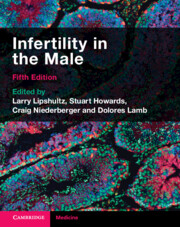30 results
Chapter 33 - Selective Androgen Receptor Modulators in the Treatment of Hypogonadism and Men’s Health
- from Section 5 - Medical and Surgical Management of Issues of Male Health
-
-
- Book:
- Men's Reproductive and Sexual Health Throughout the Lifespan
- Published online:
- 06 December 2023
- Print publication:
- 16 November 2023, pp 264-268
-
- Chapter
- Export citation
Chapter 12 - Office Evaluation of the Infertile Male
- from Section 3 - Clinical Evaluation and Treatment of Male Infertility
-
-
- Book:
- Men's Reproductive and Sexual Health Throughout the Lifespan
- Published online:
- 06 December 2023
- Print publication:
- 16 November 2023, pp 97-105
-
- Chapter
- Export citation
Chapter 35 - Sleep and Men’s Health
- from Section 5 - Medical and Surgical Management of Issues of Male Health
-
-
- Book:
- Men's Reproductive and Sexual Health Throughout the Lifespan
- Published online:
- 06 December 2023
- Print publication:
- 16 November 2023, pp 279-288
-
- Chapter
- Export citation
Section 4 - Treatment of Male Infertility
-
- Book:
- Infertility in the Male
- Published online:
- 08 July 2023
- Print publication:
- 15 June 2023, pp 399-502
-
- Chapter
- Export citation
Index
-
- Book:
- Infertility in the Male
- Published online:
- 08 July 2023
- Print publication:
- 15 June 2023, pp 541-566
-
- Chapter
- Export citation
Section 1 - Scientific Foundations of Male Infertility
-
- Book:
- Infertility in the Male
- Published online:
- 08 July 2023
- Print publication:
- 15 June 2023, pp 5-106
-
- Chapter
- Export citation
Section 2 - Clinical Evaluation of the Infertile Male
-
- Book:
- Infertility in the Male
- Published online:
- 08 July 2023
- Print publication:
- 15 June 2023, pp 107-328
-
- Chapter
- Export citation
Contributors
-
- Book:
- Infertility in the Male
- Published online:
- 08 July 2023
- Print publication:
- 15 June 2023, pp vii-x
-
- Chapter
- Export citation
Abbreviations
-
- Book:
- Infertility in the Male
- Published online:
- 08 July 2023
- Print publication:
- 15 June 2023, pp xiii-xviii
-
- Chapter
- Export citation
Section 3 - Laboratory Diagnosis of Male Infertility
-
- Book:
- Infertility in the Male
- Published online:
- 08 July 2023
- Print publication:
- 15 June 2023, pp 329-398
-
- Chapter
- Export citation

Infertility in the Male
-
- Published online:
- 08 July 2023
- Print publication:
- 15 June 2023
Section 5 - Health Care Systems and Culture
-
- Book:
- Infertility in the Male
- Published online:
- 08 July 2023
- Print publication:
- 15 June 2023, pp 503-540
-
- Chapter
- Export citation
Chapter 22 - Surgery to Improve Sperm Delivery
- from Section 4 - Treatment of Male Infertility
-
-
- Book:
- Infertility in the Male
- Published online:
- 08 July 2023
- Print publication:
- 15 June 2023, pp 413-436
-
- Chapter
- Export citation
Contents
-
- Book:
- Infertility in the Male
- Published online:
- 08 July 2023
- Print publication:
- 15 June 2023, pp v-vi
-
- Chapter
- Export citation
Introduction
-
-
- Book:
- Infertility in the Male
- Published online:
- 08 July 2023
- Print publication:
- 15 June 2023, pp 1-4
-
- Chapter
- Export citation
Foreword
-
- Book:
- Infertility in the Male
- Published online:
- 08 July 2023
- Print publication:
- 15 June 2023, pp xi-xii
-
- Chapter
- Export citation
Copyright page
-
- Book:
- Infertility in the Male
- Published online:
- 08 July 2023
- Print publication:
- 15 June 2023, pp iv-iv
-
- Chapter
- Export citation
Chapter 58 - Male infertility
- from Section 8 - Infertility and reproductive endocrinology
-
-
- Book:
- Clinical Gynecology
- Published online:
- 05 April 2015
- Print publication:
- 23 April 2015, pp 898-917
-
- Chapter
- Export citation
Contributors
-
-
- Book:
- Clinical Gynecology
- Published online:
- 05 April 2015
- Print publication:
- 23 April 2015, pp viii-xiv
-
- Chapter
- Export citation
Contributors
-
-
- Book:
- Fertility Preservation in Male Cancer Patients
- Published online:
- 05 March 2013
- Print publication:
- 21 February 2013, pp vii-x
-
- Chapter
- Export citation



